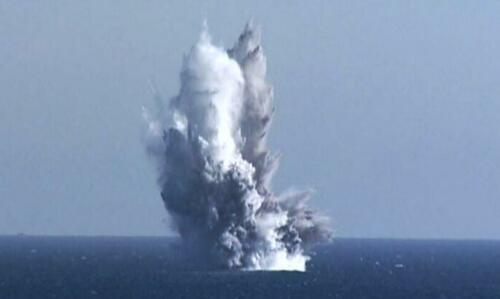
Authored by Aldgra Fredly via The Epoch Times,
North Korea has claimed it tested a new type of nuclear-capable underwater drone this week to assess the weapon’s “fatal attack ability.”
State-run Korean Central News Agency (KCNA) said on Saturday that a “Haeil-2” drone was deployed off the coast of South Hamgyong province on April 4 and reached the target in the waters off Ryongdae Port on April 7.
This photo provided by the North Korean regime, shows what it says is an underwater blast of test warhead loaded to an unmanned underwater nuclear attack craft "Haeil" during an exercise around Hongwon Bay in waters off North Korea's eastern coast on March 23, 2023. Independent journalists were not given access to cover the event depicted in this image. The content of this image is as provided and cannot be independently verified. (Korean Central News Agency/Korea News Service via AP)
KCNA said the drone cruised 1,000 kilometers (621 miles) of simulated underwater distance in the East Sea of Korea for 71 hours and six minutes before its test warhead was detonated underwater.
“The test perfectly proved the reliability of the underwater strategic weapon system and its fatal attacks ability,” KCNA claimed.
The drone test came just weeks after North Korea claimed to have tested an underwater attack drone named “Haeil” from March 21 to 23, which the regime said was capable of generating a “super-scale radioactive tsunami.”
On March 28, KCNA said that North Korea conducted another test of what it called the “Haeil-1” underwater attack drone from March 25 to 27.
North Korea said its underwater attack drone had undergone over 50 shakedowns in the past two years and is built to “stealthily infiltrate into operational waters” and make underwater explosions to destroy naval striker groups and enemy ports.
‘An Attempt At Deception’
However, analysts are skeptical of North Korea’s claims and said the regime may have “exaggerated” the drone’s capabilities. South Korea’s military said the development of the Haeil drone is still at an early stage.
“Having pieced together the South Korea-U.S. analysis of the ‘underwater nuclear attack drone’ as well as expert views on it, our military is putting weight to the possibility that the claim might have been exaggerated or fabricated,” South Korea’s Joint Chiefs of Staff said on March 27.
“There have been movements indicating the North has been working to develop an unmanned undersea vehicle, but our assessment is that it is still at an early [development] stage,” it added.
Ankit Panda, an analyst at the U.S.-based Carnegie Endowment for International Peace, said on Twitter that the underwater drone test could be “an attempt at deception” by the North Korean regime.
“I tend to take North Korea seriously, but can’t rule out the possibility that this is an attempt at deception/psyop [psychological operation]. Would be ill-advised to allocate limited fizmat for a warhead to go in this thing, [in my opinon] vs more road-mobile ballistic missiles,” he stated.
North Korea did not provide the drone’s specifications. A recent report by the Institute for Science and International Security estimated that the drone’s diameter is within 40 to 50 centimeters, analyzing a photo published by North Korean media.
“North Korea’s ability to put a nuclear warhead into an underwater drone should not be taken as given; the announced test involved conventional explosives only,” the report states.
“This diameter could conceivably hold a pure fission weapon, but it is on the small size and would likely have a yield in the range of 10 to 25 kilotons,” it added.
Anti-Submarine Drills
The United States, South Korea, and Japan conducted two-day anti-submarine exercises around the waters of South Korea’s Jeju Island on Monday to counter North Korea’s underwater threats.
South Korean Navy personnel are seen standing alongside the USS Nimitz, during its port visit to Busan on March 28, 2023. (Anthony Wallace/AFP via Getty Images)
The drills involved the U.S. nuclear-powered aircraft carrier USS Nimitz and two Arleigh Burke-class destroyers, USS Wayne E. Meyer and USS Decatur, which were deployed to South Korea’s Busan naval base last week.
“This exercise will be a good opportunity to improve the maritime operational capabilities of South Korea, the U.S. and Japan to respond to underwater threats such as North Korea’s SLBMs [submarine-launched ballistic missiles], which are advancing in sophistication,” South Korean Rear Adm. Kim In-ho said in a statement.
North Korean leader Kim Jong-un has vowed to make the United States and South Korea realize that they “are bound to lose more than they get and face a greater threat” over their “expansion of war drills in the region.”
The United States has persisted in engaging in “direct talks” with North Korea without preconditions in favor of a diplomatic solution, but North Korea has rebuffed these efforts.
Authored by Aldgra Fredly via The Epoch Times,
North Korea has claimed it tested a new type of nuclear-capable underwater drone this week to assess the weapon’s “fatal attack ability.”
State-run Korean Central News Agency (KCNA) said on Saturday that a “Haeil-2” drone was deployed off the coast of South Hamgyong province on April 4 and reached the target in the waters off Ryongdae Port on April 7.
This photo provided by the North Korean regime, shows what it says is an underwater blast of test warhead loaded to an unmanned underwater nuclear attack craft “Haeil” during an exercise around Hongwon Bay in waters off North Korea’s eastern coast on March 23, 2023. Independent journalists were not given access to cover the event depicted in this image. The content of this image is as provided and cannot be independently verified. (Korean Central News Agency/Korea News Service via AP)
KCNA said the drone cruised 1,000 kilometers (621 miles) of simulated underwater distance in the East Sea of Korea for 71 hours and six minutes before its test warhead was detonated underwater.
“The test perfectly proved the reliability of the underwater strategic weapon system and its fatal attacks ability,” KCNA claimed.
The drone test came just weeks after North Korea claimed to have tested an underwater attack drone named “Haeil” from March 21 to 23, which the regime said was capable of generating a “super-scale radioactive tsunami.”
On March 28, KCNA said that North Korea conducted another test of what it called the “Haeil-1” underwater attack drone from March 25 to 27.
North Korea said its underwater attack drone had undergone over 50 shakedowns in the past two years and is built to “stealthily infiltrate into operational waters” and make underwater explosions to destroy naval striker groups and enemy ports.
‘An Attempt At Deception’
However, analysts are skeptical of North Korea’s claims and said the regime may have “exaggerated” the drone’s capabilities. South Korea’s military said the development of the Haeil drone is still at an early stage.
“Having pieced together the South Korea-U.S. analysis of the ‘underwater nuclear attack drone’ as well as expert views on it, our military is putting weight to the possibility that the claim might have been exaggerated or fabricated,” South Korea’s Joint Chiefs of Staff said on March 27.
“There have been movements indicating the North has been working to develop an unmanned undersea vehicle, but our assessment is that it is still at an early [development] stage,” it added.
Ankit Panda, an analyst at the U.S.-based Carnegie Endowment for International Peace, said on Twitter that the underwater drone test could be “an attempt at deception” by the North Korean regime.
“I tend to take North Korea seriously, but can’t rule out the possibility that this is an attempt at deception/psyop [psychological operation]. Would be ill-advised to allocate limited fizmat for a warhead to go in this thing, [in my opinon] vs more road-mobile ballistic missiles,” he stated.
North Korea did not provide the drone’s specifications. A recent report by the Institute for Science and International Security estimated that the drone’s diameter is within 40 to 50 centimeters, analyzing a photo published by North Korean media.
“North Korea’s ability to put a nuclear warhead into an underwater drone should not be taken as given; the announced test involved conventional explosives only,” the report states.
“This diameter could conceivably hold a pure fission weapon, but it is on the small size and would likely have a yield in the range of 10 to 25 kilotons,” it added.
Anti-Submarine Drills
The United States, South Korea, and Japan conducted two-day anti-submarine exercises around the waters of South Korea’s Jeju Island on Monday to counter North Korea’s underwater threats.
South Korean Navy personnel are seen standing alongside the USS Nimitz, during its port visit to Busan on March 28, 2023. (Anthony Wallace/AFP via Getty Images)
The drills involved the U.S. nuclear-powered aircraft carrier USS Nimitz and two Arleigh Burke-class destroyers, USS Wayne E. Meyer and USS Decatur, which were deployed to South Korea’s Busan naval base last week.
“This exercise will be a good opportunity to improve the maritime operational capabilities of South Korea, the U.S. and Japan to respond to underwater threats such as North Korea’s SLBMs [submarine-launched ballistic missiles], which are advancing in sophistication,” South Korean Rear Adm. Kim In-ho said in a statement.
North Korean leader Kim Jong-un has vowed to make the United States and South Korea realize that they “are bound to lose more than they get and face a greater threat” over their “expansion of war drills in the region.”
The United States has persisted in engaging in “direct talks” with North Korea without preconditions in favor of a diplomatic solution, but North Korea has rebuffed these efforts.
Loading…






